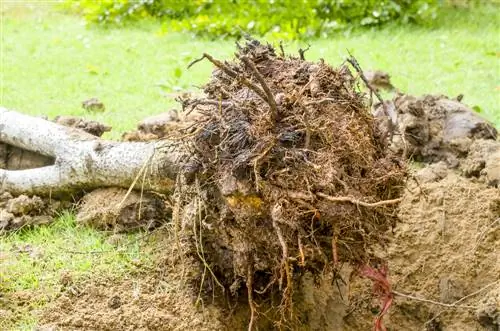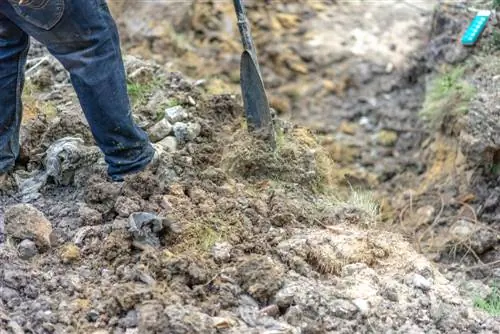- Author admin [email protected].
- Public 2023-12-16 16:46.
- Last modified 2025-01-23 11:21.
Box was previously considered an uncomplicated, pruning-friendly and very versatile garden tree. Unfortunately, pests such as the box tree borer or diseases such as shoot death have been destroying large populations for several years - often so quickly that gardeners can hardly keep up with countermeasures. Sometimes the only alternative is to remove the affected socket.

How to dig up a boxwood?
To dig up a boxwood, dig up a generous area around the plant to expose the root system. Loosen the soil and carefully remove the boxwood and its roots without breaking them.
Save or dig up an infected boxwood?
Boxwood borers and other pests eat infected trees and bushes bare within a very short time. There seem to be hardly any countermeasures and in many cases they only take effect in the very short term. It becomes particularly difficult when it comes to saving bed borders and other boxwood hedges: collecting the caterpillars is almost impossible with so many densely planted plants, so that the infestation pressure can hardly be contained. Not every gardener wants to constantly handle toxic chemical agents in the garden - completely understandable. The only alternative is often to permanently remove the buxus.
Alternative plants
To limit the damage from the outset, you should use resistant boxwood species and varieties such as 'Herrenhausen', 'Arborescens', 'Faulkner' and 'Elegantissima'. These are also attacked, but much less often than more sensitive buxus such as 'Blue Heinz', 'Suffruticosa', 'Handworthiana', 'Raket' and Rotundifolia'. If you want to be on the safe side, choose substitute plants of other, similar species such as
- Japanese holly (Ilex crenata)
- Glossy honeysuckle (Lonicera nitida)
- Privet (such as Ligustrum vulgare 'Lodense')
- Barberry (such as Berberis buxifolia 'Nana' or 'Kobold')
- Tree of life (such as Thuja occidentalis 'Teddy')
How to remove unwanted boxwood
Box is a very pruning-tolerant plant that keeps sprouting. At the same time, the shallow-rooted plant is difficult to remove because its roots grow very broadly branched. Of course, it is best to dig up the plants completely including their roots. However, if you don't want to or can't do this work, these measures are also effective:
- Cut the box in midsummer to just above the ground.
- Be sure to dispose of infected clippings in airtight packaging with household waste.
- Never compost this or dispose of it in the organic waste bin.
- Cover the interfaces with weed film (€34.00 on Amazon) or ericaceous soil or fertilizer.
- Box only likes high pH values and will sprout less here.
- Cut off or pull out any shoots again and again.
- After a year the book problem should be gone.
Tip
In locations where a fungal disease or a pest such as the boxwood borer has already occurred, no new boxwood plants should be planted for at least four years.






